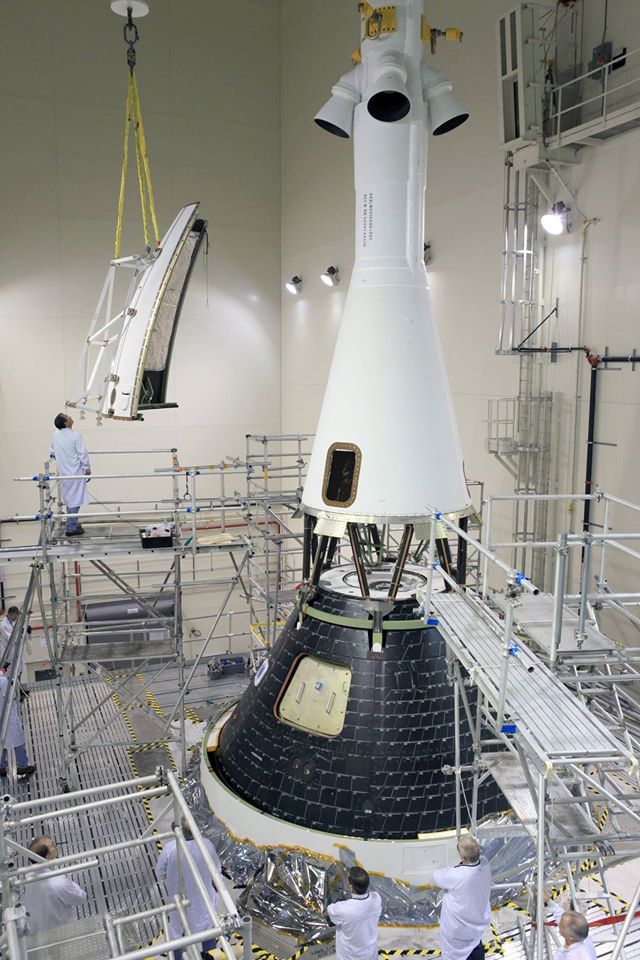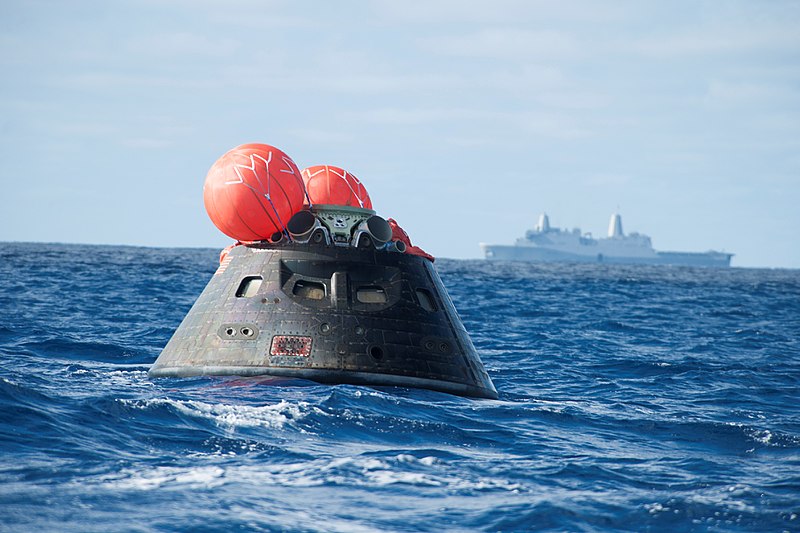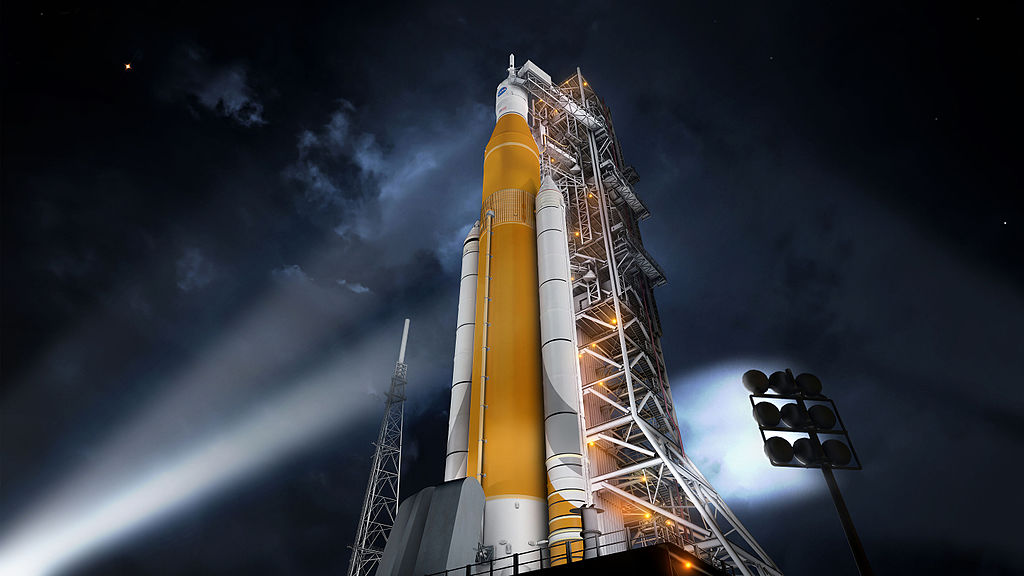Space Launch System / Orion / Artemis Fact Sheet
By Cliff Lethbridge
NASA has embarked on a brand new program to send humans beyond Earth orbit to destinations like the Moon, Mars, asteroids and beyond. The program is called Artemis, named for the sister of Apollo. Immediate plans are for a human landing on the Moon by 2024, with the goal of sending the first woman to the lunar surface. Mission Artemis-1, set for launch in 2021, will be an unmanned orbital lunar mission to test the Orion spacecraft and Space Launch System (SLS). SLS will be used for launch while Orion will carry the crew. Both elements are described below.
Orion Spacecraft

Artist Conception Of Orion In Space, Photo Courtesy NASA
Classification: Manned Spacecraft
Crew Module Height: 11 Feet
Crew Module Diameter: 16 Feet
Crew Module Pressurized Volume: 691 Cubic Feet
Crew Module Habitable Volume: 316 Cubic Feet
Launch Abort System Liftoff Weight: 16,850 pounds
Crew Module Liftoff Weight: 22,900 Pounds
Service Module Liftoff Weight: 34,085 Pounds
Spacecraft Adapter Liftoff Weight: 4,175 Pounds
Crew Size: 4
For the first time in a generation, NASA is building a new human spacecraft that will usher in a new era of space exploration. Named after one of the largest constellations in the night sky and drawing upon more than 50 years of spaceflight research and development, the Orion spacecraft will meet the evolving needs of America’s deep exploration program for decades to come. Orion will be the safest, most advanced spacecraft ever built, and will be flexible enough to take us to a variety of exciting destinations.

Orion Elements, Photo Courtesy NASA
Orion features dozens of technology advancements and innovations. The spacecraft features a crew module, a service module, a spacecraft adapter and a revolutionary new launch abort system. The crew module can transport four crew members beyond low-Earth orbit, providing a safe habitat from launch through landing and recovery.

Orion Crew Module And Launch Abort System, Photo Courtesy NASA
The service module provides support of the crew module from launch through crew module separation prior to re-entry. It provides in-space propulsion capability for orbital transfer, attitude control and if necessary high altitude ascent aborts. While mated to the crew module, it also provides water, oxygen and nitrogen to support the crew module living environment. The service module also generates and stores power while in space and provides primary thermal control. It is also able to accommodate unpressurized cargo. The launch abort system, positioned above the crew module, can activate within milliseconds to pull the crew to safety in the event of an in-flight emergency and position the crew module for a safe recovery. The spacecraft adapter provides the connection between the service module and the launch vehicle’s upper stage.

Unmanned Orion Maiden Launch Atop Delta IV Heavy Rocket, 12-5-2014, Photo Courtesy NASA
Orion’s unique life support, propulsion, thermal protection and avionics systems in combination with other elements will enable extended duration deep space missions. These systems have been developed to facilitate integration of new technical innovations as they become available in the future. Utilizing advances in propulsion, communications, life support, structural design, navigation and power, Orion will be able to support manned destinations to near-Earth asteroids, the Moon, the moons of Mars and ultimately Mars itself.

Unmanned Orion Crew Module Recovery, 12-5-2014, Photo Courtesy NASA
Space Launch System

Artist Conception Of Space Launch System In Flight, Photo Courtesy NASA
Classification: Space Launch Vehicle
Length (Block 1): 322 Feet
Length (Block 1B Crew): 364 Feet
Length (Block 1B Cargo): 327 Feet
Length (Block 2 Cargo): 365 Feet
Diameter (All): 27 Feet, 7 Inches
Length (SRB): 177 Feet
Diameter (SRB): 12 Feet
The NASA Space Launch System (SLS) is a powerful, advanced launch vehicle designed to usher in a new era of human exploration beyond Earth’s orbit. With unprecedented power and capabilities, SLS will launch crews in the NASA Orion spacecraft on missions to explore multiple deep-space destinations. Offering more payload mass, volume capability and energy to speed missions through space than any current launch vehicle, SLS is designed to be flexible and evolvable and will open new possibilities for payloads, including robotic scientific missions to destinations like Mars, Saturn and Jupiter.

Artist Conception Of Space Launch System Variants, Photo Courtesy NASA
To fit NASA future needs for deep-space missions, SLS is designed to evolve into increasingly more powerful configurations. The first SLS vehicle, called Block 1, has a 77-ton lift capability. It will be powered by twin five-segment solid rocket boosters and four RS-25 liquid propellant engines. The SLS Block 1 will produce about 8.8 million pounds of thrust at liftoff. It will produce 15 percent more thrust than the Saturn V and at a weight of 5.75 million pounds will carry more than three times the mass of the Space Shuttle. SLS Block 1 will be used to launch an uncrewed Orion spacecraft beyond the Moon and back, then carry a crewed Orion spacecraft the same distance, farther than humans have ever traveled.

Artist Conception Space Launch System In Flight, Photo Courtesy NASA
The SLS Block 1B crewed configuration will be taller than the Saturn V rocket and will be used to launch humans on more ambitious missions beyond the Moon, to the proving ground of space where NASA will test systems needed for the journey to Mars. Utilizing an Exploration Upper Stage, the Block 1B can, in a single launch, carry the Orion spacecraft along with exploration systems like a small deep-space habitat module or science spacecraft. The next evolved configuration, the SLS Block 2, will be the workhorse vehicle for assembling a human mission to Mars. Using improved engines and solid rocket boosters, SLS Block 2 will have a liftoff thrust of about 9.2 million pounds.

Space Launch System Core Stage Under Construction, Photo Courtesy NASA
SLS consists of a core stage, four RS-25 engines, two solid rocket boosters and a variety of payload adapters, fairings and upper stages. The core stage is more than 200 feet tall and 27 feet, seven inches in diameter. It will store more than 730,000 gallons of super-cooled liquid oxygen and liquid hydrogen to feed the engines. Propulsion for the core stage will be provided by the four RS-25 engines, being upgraded from main engines left over from the Space Shuttle program. Improvements to the engines include a new engine controller, nozzle insulation and increased thrust to 418,000 pounds each, up from 395,000 pounds each when used on the Space Shuttle.

Space Launch System Solid Rocket Booster Segment, Photo Courtesy NASA
The twin solid rocket boosters, the most powerful ever built, are derived from the Space Shuttle program. Each weighs 1.6 million pounds and can produce a liftoff thrust of 3.6 million pounds. Performance enhancements over the Space Shuttle version are derived primarily from the addition of a booster segment. The SLS solid rocket boosters employ five segments, up from four segments for the Space Shuttle boosters. This accommodates about 25 percent more fuel for greater thrust and burn time. Other improvements include a new nozzle design, new asbestos-free insulation and liner configuration and new avionics. Unlike the Space Shuttle boosters, the SLS solid rocket boosters will not be recovered. The SLS solid rocket boosters burn polybutadiene acrylonitrile (PBAN) solid fuel.

Artist Conception Space Launch System On Launch Pad 39B, Photo Courtesy NASA


